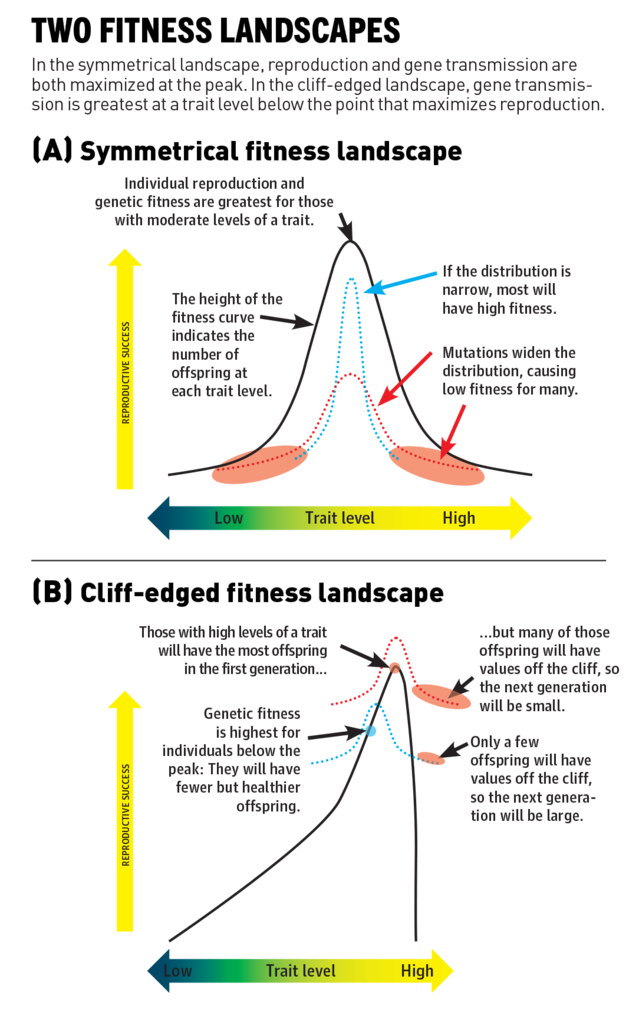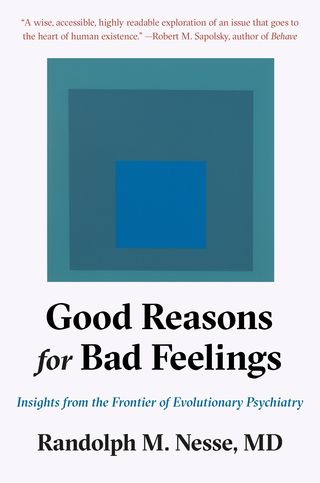The Puzzle of the Unbalanced Mind
Natural selection for extreme mental capacities may have made human minds fast and powerful, but also vulnerable to serious upheaval. Such a “gene’s-eye view” sheds light on schizophrenia, autism, and other psychiatric disorders.
By Randolph Nesse M.D. published March 4, 2019 - last reviewed on April 9, 2019

The genius whose life and struggle with schizophrenia were depicted in the film A Beautiful Mind, John Nash, made huge contributions to mathematics. Did he innovate despite having schizophrenia—or perhaps because of it? Scores of spectacularly creative people, including Ernest Hemingway and Vincent van Gogh, are thought to have had bipolar disorder. Savants with autism (such as the real "Rain Man," Kim Peek) are also well-documented. Such examples make it tempting to view these disorders as useful adaptations, but that is a serious error. Evolutionary medicine instead asks why natural selection has left us all vulnerable to such diseases. To find possible answers, we must examine how they differ—and what they have in common.
Schizophrenia is a cognitive collapse in which every event is imbued with excess personal meaning, and the inability to separate inner life from outer life gives rise to hallucinations and delusions. Autism is manifested in early childhood by a lack of social connectedness and solitary preoccupation with repeated motions and nonsocial thinking. Bipolar disorder is the product of a broken mood-regulation system that causes alternating periods of depression and mania.
Despite the differences, the overlapping features of these disorders make an evolutionary perspective on them especially useful. Each afflicts approximately 1 percent of populations worldwide. Each has milder forms that affect 2 to 5 percent of people. Vulnerability depends overwhelmingly on what genes a person has, but people with schizophrenia or autism have far fewer children than other people, and one out of five individuals with bipolar disorder commits suicide. These diseases are not just difficult to endure, they are also costly, in an evolutionary sense, to an individual's fitness—the capacity to produce offspring who, in turn, also reproduce.
The evolutionary question is obvious: Why hasn't natural selection eliminated the genetic variations that cause these costly disorders?
A mechanic's approach to mental illness assumes that specific disorders can be defined by identifiable brain pathology with specific genetic causes. An evolutionary perspective, by contrast, encourages an engineer's view, which asks why the brain was not better designed. Evolutionary medicine considers several possible reasons, including modern environments that differ from those in which humans originally evolved, the limitations of what natural selection can do, and trade-offs that make systems inherently vulnerable to failure.
Many people in the United States have listened to Car Talk, the old public radio show in which the cohosts, "Click and Clack," discussed automotive problems with thick Boston accents and rollicking humor. Callers described arcane glitches. Sally in Dallas has an MG that won't start after being driven on a hot day. The hosts first diagnose her car's problem: vapor lock. They then explain the cause: The fuel pump can move only liquid, so when the gasoline in a hot fuel line vaporizes, the car won't start until it cools down. But they then go on from a mechanic's explanation of one car's problem to provide an engineer's explanation of why vapor lock is an inherent problem for all cars with carburetors.
When I was a teenager growing up near Detroit, I listened to an automotive engineer neighbor talk about trying to prevent vapor lock. I said, "Well, if it is just too much heat, that should be easy to solve." His reply: "Oh, yeah? It's hot above an engine. Where else would you put the fuel pump and carburetor?" He had little patience for a kid who did not understand that vapor lock is an intrinsic vulnerability with no easy solution.
Could schizophrenia, autism, and bipolar disorder result from similar intrinsic vulnerabilities in human minds?

Putting The Pieces Together
The evidence that these disorders have genetic causes is strong. Having a parent or sibling with one of them increases the risk roughly tenfold. Having an identical twin with one of these disorders increases one's risk to over 50 percent. That there is a remaining 50 percent makes it seem as if some environmental factor should be identifiable. However, studies of adopted children show that the family in which a child is raised has little influence on risk. It is much more likely that the differences between identical twins result from chance variations influencing brain development, such as which genes are turned on or turned off when and how the paths of neurons wander as they grow.
I wish I had known sooner that these are genetic diseases. I recall trying to console a mother who was bereft because her son's doctors would not allow her to visit him during a hospital stay of several months for psychosis; they said her early relationship with him had contributed to his schizophrenia. She was furious, but she also wondered if they might be right. This was the 1970s, and I did not know enough then to tell her and her doctors firmly that parenting does not cause schizophrenia. Autism, too, was incorrectly blamed on parents, especially on women viewed as intellectualized "refrigerator mothers."
By the turn of the millennium, however, hope was high that specific genetic variations (alleles) that cause these diseases would soon be found. A few disorders are caused by specific genetic abnormalities with big effects. Huntington's disease is a good example: If you have the allele, you get that devastating disease. As it turns out, however, most common genetic diseases are very different. Instead of a few genetic variations with big effects, they are caused by thousands of variations spread across the genome, each with only a tiny effect. This is the case for type II diabetes, high blood pressure, coronary artery disease, migraine headaches, and obesity, and also for schizophrenia, autism, and bipolar disorder.
As our species evolved, there should have been strong pressure from natural selection to remove the versions of genes that cause these disorders. But there are limits to what selection can do. In an influential 2006 paper, behavioral geneticist Matthew Keller and evolutionary psychologist Geoffrey Miller concluded that the most plausible explanation for the persistence of these disorders is that new genetic mutations are continually created and only slowly removed from a population by natural selection. That is certainly one major cause of mental disorders.
A model based only on mutation, however, implies that some combination of normal genes could prevent disease completely while also maximizing evolutionary fitness. This may be incorrect. Some other possibilities also deserve consideration.
One is the intriguing idea, developed by evolutionary biologist Bernard Crespi, sociologist Christopher Badcock, and colleagues, that schizophrenia and autism are genetic flip sides of the same coin. In this theory, both conditions result from genes that perpetuate their own transmission despite costs to the individual who possesses them. The logic is based on the recognition that chemical tags that are placed on chromosomes early in development can inhibit the expression of certain genes. This process, "genomic imprinting," can turn off genes selectively, depending on whether they come from the mother or from the father.
Alleles that come from mothers are more likely to be passed on to future generations if they keep a fetus relatively small; this conserves the mother's resources for a future pregnancy and helps to ensure safe childbirth. In contrast, genes from the paternal line are more likely to persist if they make a baby bigger (relative to the norm), using more of the mother's stored calories to give the baby a head start, since her subsequent offspring may have a different father. Crespi has assembled evidence that excess dominance of paternal alleles may increase the risk of autism, while excess unopposed activity of maternal alleles may increase the risk of schizophrenia. This hypothesis predicts that babies born a bit heavier than average will have an increased risk of autism, and those born a bit lighter than average will have an increased risk of schizophrenia. Remarkably, a study of millions of people in Denmark confirmed the prediction.

Another theory speaks to the much higher prevalence of autism in boys than in girls. This suggested to Simon Baron-Cohen and colleagues that autism is a product of an extremely male brain. Does the sex difference in rates of autism result from early exposure to testosterone, genomic imprinting, the process that inactivates one of the X chromosomes in women, or something else? The answer to these questions may provide the key to understanding autism.
The huge fitness costs of these diseases have also inspired suggestions that their symptoms, or the alleles that cause them, must offer selective advantages. One idea is that schizophrenics have traditionally become shamans or charismatic leaders, and the resulting status has gotten them more reproductive opportunities. This not only seems unlikely, it is also inconsistent with data showing that people with these diseases have fewer children.
The same genetic tendencies that make a disorder more likely could, however, give other advantages. Substantial research has considered the possible association of creativity and intelligence with bipolar disorder. My exceptionally creative academic friends seem especially likely to have children with major mental disorders, and my patients with severe disorders also seem to have relatives who are exceptionally creative. But this could be an illusion. Such individuals are easier to remember because they fit the pattern. Also, some people with serious disorders may choose creative occupations because they have a hard time getting and keeping other kinds of jobs. Some traits associated with bipolar disorder probably do give advantages, but I am unconvinced that creativity is a major influence on the persistence of the disorder; it may instead be a sometimes-fortunate side effect of mood dysregulation and its complications.
Yet full-fledged bipolar illness is just the tip of a spectrum of mood instability disorders, as a series of studies by the psychiatrist Hagop Akiskal and colleagues has shown. It is plausible that mild versions of mood instability, which are more common, might increase reproductive success on average over the long run—perhaps because of productivity during bursts of manic energy or because such people have more sex partners.
While caution is warranted when considering these proposals, several new studies support the idea that genetic variants that increase vulnerability have related benefits. A study of twins found that the likelihood of developing bipolar disorder is associated with higher-than-average levels of sociality and verbal skills. Recently, Yale geneticists Renato Polimanti and Joel Gelernter found that natural selection has increased the prevalence of certain alleles that make autism spectrum disorder more likely, perhaps because they also confer cognitive benefits. Another study showed that the amount of a protein made by genes related to schizophrenia was associated with verbal learning ability. And many of the suggestions for why schizophrenia alleles persist consider the general idea that they were selected for in the process that shaped human cognition and language.
Minds at A Cliff's Edge
The above ideas all help to explain the persistence of alleles that cause dreaded disorders, but I found myself still wondering why natural selection did not greatly reduce their frequency. If they occurred in just 0.001 percent of people, that would be different, but 1 percent is relatively common.
I finally found inspiration by rereading early studies by the British ornithologist David Lack. Lack wondered why birds didn't lay more eggs in order to have more offspring; he suspected that additional eggs would sometimes result in fewer surviving fledglings. Indeed, he found that when food supplies were unreliable, nests with two eggs fledged more offspring than nests with three. His insight inspired me to wonder if similar circumstances might help to explain vulnerability to schizophrenia.
Biologists use the metaphor of a "fitness landscape" to think about how variations in a trait influence fitness in an evolutionary sense. For instance, birds that have wings that are longer or shorter than average are less likely to survive a storm. Long wings have both advantages and disadvantages, and short wings have opposite advantages and disadvantages. So the fitness landscape for wing length is shaped like a hill, with a fitness peak in the middle, at medium wing lengths.
In the standard model for vulnerability, such trade-offs are central. Risk-taking rabbits are at high risk of predation, but they have plenty of time to eat. Cautious rabbits are protected from predation, but they have too little time to eat. Rabbits with medium levels of cautiousness have the highest fitness, so natural selection shapes the population average to a medium level. But mutations result in some individuals having trait values that are higher or lower than the average, causing lower fitness.
Sometimes, however, fitness increases as a trait is pushed in one direction—but going one step too far results in falling off a cliff, just like the bird nest that had one egg too many. Racehorses, for example, are prone to breaking the cannon bone in their legs. Breeding only the fastest horses made their leg bones longer, thinner, and lighter. Successive generations of racehorses have become faster but also more prone to breaking a leg.
Natural selection for extreme mental capacities may have given humans minds like the legs of racehorses: fast and otherwise extremely powerful, but vulnerable to catastrophic failures. This model fits well with the idea that schizophrenia is intimately related to language and cognitive ability. It also fits well with the observation that schizophrenia and autism may be related to the human capacity for "theory of mind," our ability to intuit other people's motives and cognitive abilities in general.
Imagine that having a particular value on a psychological trait results in having the maximum number of offspring—making it a peak value in that sense—but that trait value is near a "cliff edge." (See the red dot in chart B.) Inevitable variations among those offspring will leave many with trait values "off the cliff"—making them highly vulnerable to illness. So natural selection pushes the average trait a bit below the peak. Even at this point (the blue dot), a few percent of the population will remain vulnerable. But natural selection will set the trait average to whatever value maximizes the transmission of genes overall, even if that results in dire illness for a few individuals. Diseases resulting from such cliff-edged fitness functions would be highly heritable, and the risk would be influenced by the complex interactions of many normal alleles that all have about the same small influence on disease risk. This matches the data for many diseases.

Many human traits are subject to catastrophic failure. Babies with larger brains and heads have advantages, but in environments without obstetric surgery, just one centimeter too large is fatal for both mother and baby. High uric acid levels protect against aging, but just a bit too high causes gout. Competition between hosts and pathogens is especially likely to create steep cliffs. Since the price of not being able to defend against an infection is death, the immune system is shaped to such a level of aggressiveness that it sometimes attacks normal tissues. The consequence can be rheumatic fever, OCD, rheumatoid arthritis, multiple sclerosis, and other disorders.

A trade-off may also be involved in Alzheimer's disease. Dying and dead neurons are usually surrounded by a protein called amyloid beta. Scientists have often assumed that this protein is a toxic byproduct of metabolism. But it has recently been discovered that amyloid beta is a potent antimicrobial agent. Our vulnerability to Alzheimer's disease may be related to a trade-off between the protective effects of amyloid beta and the costs of potent protection against infection.
Many diseases may result from natural selection stabilizing traits at the point close to a cliff edge that maximizes genetic fitness for the overall population despite the negative outcomes for a smaller group. This idea is not yet widely accepted, but it offers a potential explanation for the persistence of genetic variations that, together, cause devastating diseases in a few percent of a population.
An evolutionary view moves beyond the easy assumption that because severe disorders are influenced by genes, they are caused by defective genes. It calls new attention to traits and trade-offs that may result in vulnerabilities for some. The traits are unlikely to be as obvious as creativity or intelligence. Instead, they may be such factors as rates of neuron growth in early development, rates of neuron pruning in adolescence, and rates of transmission in neural networks. Tradeoffs at higher levels may also be important; for example, a tendency to attribute meaning to tiny gestures by others may be increasingly useful up to some peak—beyond which the trait crashes into sustained paranoia.
The actual systems at play are likely to be complex and difficult to identify. Nonetheless, investigating how natural selection shapes human traits to maximize fitness—but leaves some people vulnerable—suggests a way to expand the search for the keys to genetic diseases.

Randolph M. Nesse, M.D., is a founder of the field of evolutionary medicine and the author of Good Reasons for Bad Feelings: Insights From the Frontier of Evolutionary Psychiatry. He is co-author with George C. Williams of Why We Get Sick. References for this article are available at his website, nesse.us.
From GOOD REASONS FOR BAD FEELINGS by Randolph M. Nesse, MD, published by Dutton, an imprint of Penguin Publishing Group, a division of Penguin Random House LLC. Copyright ©2019 by Randolph M. Nesse, MD.
Submit your response to this story to letters@psychologytoday.com. If you would like us to consider your letter for publication, please include your name, city, and state. Letters may be edited for length and clarity.
Pick up a copy of Psychology Today on newsstands now or subscribe to read the rest of the latest issue.
Facebook/LinkedIn image: KieferPix/Shutterstock
